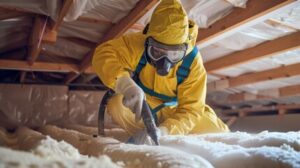A thermostat is a device that controls the temperature of your home. It may be used to control electric or oil furnaces, electric baseboard heaters and hot water systems.
A smart thermostat can take your daily routine into account and learn your energy preferences. It can also save you money on heating and cooling. Click the Thermostat In Recovery to learn more.

A programmable thermostat can save you energy and money by automatically adjusting the heating and cooling settings for different times of day. It can do this by recording your preferred settings and triggering them at predetermined times, such as when you wake up, leave for work or school, get home, go to bed, and so on. However, it’s important to read the manual before programming the device because not all thermostats operate exactly the same way.
The first step in a thermostat’s programming is setting the date and time. This is a vital component that helps the device keep track of your schedule and adjust its settings accordingly. Almost all programmable thermostats offer daily schedules, while some have weekly or even weekday/weekend options.
Most programmable thermostats come with preprogrammed settings that are supposed to be ideal for the average American family, but these may not match your needs. If you want your thermostat to be most effective, it’s important to set the temperature based on your household’s actual habits.
Some programmable thermostats also offer an emergency heat setting that allows you to turn on the system in case of severe weather or power outages. If you use this feature, it’s a good idea to test it regularly to make sure the system is working properly.
Programmable thermostats are available in a variety of price ranges, and you can find one that fits your budget without sacrificing features. You should also take into consideration the cost of your current HVAC system before choosing a model.
More advanced thermostats allow you to control your heating and cooling from your smartphone via wi-fi, and some can learn your preferences and maintain an optimal schedule for comfort and savings. These devices tend to be more expensive than programmable thermostats, and they require a reliable internet connection and a compatible smartphone. In addition, you’ll need to install the necessary hardware, such as a thermostat-compatible hub or router. Some of these systems are also vulnerable to outages and other issues. As a software developer, thermostats are the bane of my existence in Vera because they’re so hard to support.
Wi-Fi
A Wi-Fi thermostat is hardwired into your home’s Internet connection and lets you adjust heating and cooling temperatures via an app on your smartphone or computer. These devices can help you save money and energy by creating automatic programmable temperature settings based on daily schedules and weather conditions. They also allow you to remotely control the thermostat and can provide real-time energy usage reports.
Some smart thermostats have advanced features that go beyond programmable controls, such as geofencing and energy tracking. These features can help you save money by adjusting your home’s temperature when you are away from home, for example by making the house cooler when you go to bed or warmer when you return. Others take your work or school schedule into account when determining optimal heating and cooling schedules, helping to reduce your energy consumption. This can lead to fewer greenhouse gas emissions, and a more sustainable future for the planet.
Most smart thermostats are compatible with other connected devices in your home, such as lights and switches, through the Internet of Things. Some are even compatible with voice assistants like Amazon Alexa or Google’s Siri, allowing you to control the thermostat by using your voice. You can also set up a third-party service, such as IFTTT (If This Then That), to trigger other devices and services to automatically adjust your thermostat.
The LYRIC model of the Nest Learning Thermostat is an excellent example of a thermostat that works well with other smart devices, and can be controlled via an app. Other manufacturers, such as Ecobee, also make thermostats that connect with other smart devices. Make sure the thermostat you choose is compatible with other smart systems in your home, and consider a device that supports IFTTT or another open platform, such as Matter.
Smart thermostats are one of the simplest ways to cut your heating and cooling costs. They are available at a variety of price points, and many of them are easy to install. The average homeowner spends around $300-400 each year on heating and cooling, so a smart thermostat can save you a significant amount of money in the long run.
Sensors
Thermostat sensors are a vital component of any heating and cooling system. They are used to measure the air temperature and work with thermostats to ensure that your home or office is always at the ideal level of comfort. Some are installed inside the thermostat, while others operate remotely.
Regardless of their location, all thermostats rely on a sensor to function. Thermostat sensors have a unique design that allows them to measure temperature fluctuations quickly and accurately. They are also used in other applications such as detecting humidity levels and indoor air quality.
A thermostat’s built-in sensors are usually made from coiled bimetallic strips that change their shape depending on the air temperature. Thermostat sensors with more advanced designs offer a greater degree of accuracy. For example, some have a pair of metal discs with a gas-filled bellows in between. The inner disc has a larger surface area than the outer, so it reacts more quickly to changes in temperature. When the inner disc reaches a higher temperature than the outer, it pushes against a microswitch in the middle, turning off the electric circuit and shutting off the heating.
Many smart thermostats feature advanced technology designed to enhance energy efficiency. For example, they can “learn” occupant patterns by recognizing when people are at home or away and automatically adjusting temperature settings. Some feature remote access via mobile apps or voice commands, allowing users to control their buildings’ climate from anywhere in the world.
Some smart thermostats come equipped with sensors that monitor the air’s quality, including volatile organic compounds (VOCs). These can lead to drowsiness and a decrease in cognitive function, so they need to be controlled and monitored carefully. Smart thermostats with these sensors can alert users to a high concentration of VOCs, allowing them to take steps to reduce their exposure.
Another important feature that smart thermostats have is motion or geo-fencing sensors. These leverage the user’s smartphone’s GPS capabilities to automatically adjust the device to a pre-set, energy-saving temperature when the owner is within a set radius of their home or office. This can save money on energy bills by avoiding overheating or overcooling rooms that nobody is using.
Convenience
Whether you’re home or away, you can adjust your thermostat settings using a smartphone app. This convenience helps you save energy and stay comfortable. You can also monitor your energy usage, which may help you spot inefficient behaviors and take steps to correct them.
The most advanced thermostats come with built-in voice control compatibility, allowing you to change your heating and cooling settings with simple commands. This feature is convenient for busy families. Some thermostats are also equipped with temperature sensors that can track the temperature in different rooms or zones of your home, enabling you to manage hot and cold spots. This can be particularly useful for homes with forced-air systems.
Smart thermostats are designed to optimize the performance of your heating and cooling system, reducing energy waste. They learn your schedule and preferences, automatically adjusting your home’s temperature to match. This automation can significantly reduce your energy usage, saving you money on utility bills in Concord and Rock Hill.
In addition to learning your schedule and preferences, a smart thermostat can integrate with other home automation systems like smart lighting, security systems, and more. This allows you to create a seamless, connected home environment. For example, you can have your thermostat lower the lights and arm your security system at bedtime.
Another added convenience is the ability to remotely access your thermostat settings from anywhere in the world with wi-fi connectivity. This allows you to make changes from work, on vacation, or even while sitting at a restaurant sipping margaritas.
While these features are great, smart thermostats are more expensive than manual or programmable models. If you’re on a budget, a manual or non-programmable thermostat may be a better option for your needs. However, you can receive instant discounts on eligible HVAC equipment by working with a Trade Ally Contractor.







